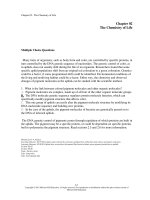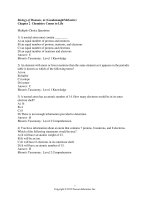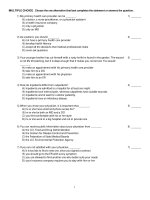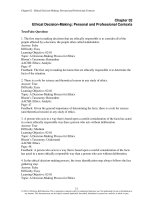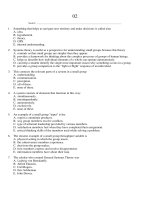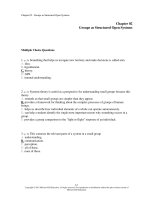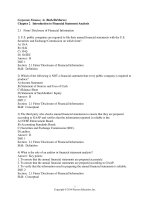Finance applications and theory 3rd edition cornett test bank
Bạn đang xem bản rút gọn của tài liệu. Xem và tải ngay bản đầy đủ của tài liệu tại đây (5.02 MB, 163 trang )
Chapter 02
Reviewing Financial Statements
Multiple Choice Questions
1.
Which financial statement reports a firm's assets, liabilities, and equity at a particular point in time?
A. Balance sheet
B. Income statement
C. Statement of retained earnings
D. Statement of cash flows
2.
Which financial statement shows the total revenues that a firm earns and the total expenses the
firm incurs to generate those revenues over a specific period of time—generally one year?
A. Balance sheet
B. Income statement
C. Statement of retained earnings
D. Statement of cash flows
2-1
Copyright © 2015 McGraw-Hill Education. All rights reserved. No reproduction or distribution without the prior written consent of
McGraw-Hill Education.
3.
Which financial statement reports the amounts of cash that the firm generated and distributed
during a particular time period?
A. Balance sheet
B. Income statement
C. Statement of retained Earnings
D. Statement of cash Flows
4.
Which financial statement reconciles net income earned during a given period and any cash
dividends paid within that period using the change in retained earnings between the beginning
and end of the period?
A. Balance sheet
B. Income statement
C. Statement of retained earnings
D. Statement of cash flows
5.
On which of the four major financial statements would you find the common stock and paid-in
surplus?
A. Balance sheet
B. Income statement
C. Statement of cash flows
D. Statement of retained earnings
2-2
Copyright © 2015 McGraw-Hill Education. All rights reserved. No reproduction or distribution without the prior written consent of
McGraw-Hill Education.
6.
On which of the four major financial statements would you find the increase in inventory?
A. Balance sheet
B. Income statement
C. Statement of cash flows
D. Statement of retained earnings
7.
On which of the four major financial statements would you find net plant and equipment?
A. Balance sheet
B. Income statement
C. Statement of cash flows
D. Statement of retained earnings
8.
Financial statements of publicly traded firms can be found in a number of places. Which of the
following is NOT an option for finding publicly traded firms' financial statements?
A. Facebook
B. A firm's website
C. Securities and Exchange Commission's (SEC) website
D. Websites such as finance.yahoo.com
2-3
Copyright © 2015 McGraw-Hill Education. All rights reserved. No reproduction or distribution without the prior written consent of
McGraw-Hill Education.
9.
For which of the following would one expect the book value of the asset to differ widely from its
market value?
A. Cash
B. Accounts receivable
C. Inventory
D. Fixed assets
10. Common stockholders' equity divided by number of shares of common stock outstanding is the
formula for calculating
A. Earnings per share (EPS).
B. Dividends per share (DPS).
C. Book value per share (BVPS).
D. Market value per share (MVPS).
11. When a firm alters its capital structure to include more or less debt (and, in turn, less or more
equity), it impacts which of the following?
A. The residual cash flows available for stock holders
B. The number of shares of stock outstanding
C. The earnings per share (EPS)
D. All of the choices
2-4
Copyright © 2015 McGraw-Hill Education. All rights reserved. No reproduction or distribution without the prior written consent of
McGraw-Hill Education.
12. This is the amount of additional taxes a firm must pay out for every additional dollar of taxable
income it earns.
A. Average tax rate
B. Marginal tax rate
C. Progressive tax system
D. Earnings before tax
13. An equity-financed firm will:
A. pay more in income taxes than a debt-financed firm.
B. pay less in income taxes than a debt-financed firm.
C. pay the same in income taxes as a debt-finance firm.
D. not pay any income taxes.
14. Deferred taxes occur when a company postpones taxes on profits pertaining to:
A. tax years they are under an audit by the Internal Revenue Service.
B. funds they have not collected because they use the accrual method of accounting.
C. a loss they intend to carry back or carry forward on their income tax returns.
D. a particular period as they end up postponing part of their tax liability on this year's profits to
future years.
2-5
Copyright © 2015 McGraw-Hill Education. All rights reserved. No reproduction or distribution without the prior written consent of
McGraw-Hill Education.
15. Net operating profit after taxes (NOPAT) is defined as which of the following?
A. Net profit a firm earns before taxes, but after any financing costs
B. Net profit a firm earns after taxes, and after any financing cots
C. Net profit a firm earns after taxes, but before any financing costs
D. Net profit a firm earns before taxes, and before any financing cost
16. This is cash flow available for payments to stockholders and debt holders of a firm after the firm
has made investments in assets necessary to sustain the ongoing operations of the firm.
A. Net income available to common stockholders
B. Cash flow from operations
C. Net cash flow
D. Free cash flow
17. Which of the following activities result in an increase in a firm's cash?
A. Decrease fixed assets
B. Decrease accounts payable
C. Pay dividends
D. Repurchase of common stock
2-6
Copyright © 2015 McGraw-Hill Education. All rights reserved. No reproduction or distribution without the prior written consent of
McGraw-Hill Education.
18. These are cash inflows and outflows associated with buying and selling of fixed or other long-term
assets.
A. Cash flows from operations
B. Cash flows from investing activities
C. Cash flows from financing activities
D. Net change in cash and cash equivalents
19. If a company reports a large amount of net income on its income statement during a year, the firm
will have:
A. positive cash flow.
B. negative cash flow.
C. zero cash flow.
D. Any of these scenarios are possible.
20. Free cash flow is defined as:
A. cash flows available for payments to stockholders of a firm after the firm has made payments to
all others will claims against it.
B. cash flows available for payments to stockholders and debt holders of a firm after the firm has
made payments necessary to vendors.
C. cash flows available for payments to stockholders and debt holders of a firm after the firm has
made investments in assets necessary to sustain the ongoing operations of the firm.
D. cash flows available for payments to stockholders and debt holders of a firm that would be taxfree to the recipients.
2-7
Copyright © 2015 McGraw-Hill Education. All rights reserved. No reproduction or distribution without the prior written consent of
McGraw-Hill Education.
21. The Sarbanes-Oxley Act requires public companies to ensure which of the following individuals
have considerable experience applying generally accepted accounting principles (GAAP) for
financial statements.
A. External auditors
B. Internal auditors
C. Chief financial officers
D. Corporate boards' audit committees
22. Balance Sheet You are evaluating the balance sheet for Campus Corporation. From the balance
sheet you find the following balances: cash and marketable securities = $400,000, accounts
receivable = $200,000, inventory = $100,000, accrued wages and taxes = $10,000, accounts
payable = $300,000, and notes payable = $600,000. What is Campus's net working capital?
A. -$210,000
B. $700,000
C. $910,000
D. $1,610,000
23. Balance Sheet Jack and Jill Corporation's year-end 2013 balance sheet lists current assets of
$250,000, fixed assets of $800,000, current liabilities of $195,000, and long-term debt of $300,000.
What is Jack and Jill's total stockholders' equity?
A. $495,000
B. $555,000
C. $1,050,000
D. There is not enough information to calculate total stockholder's equity.
2-8
Copyright © 2015 McGraw-Hill Education. All rights reserved. No reproduction or distribution without the prior written consent of
McGraw-Hill Education.
24. Income Statement Bullseye, Inc.'s 2013 income statement lists the following income and expenses:
EBIT = $900,000, interest expense = $85,000, and net income = $570,000. What are the 2013 taxes
reported on the income statement?
A. $245,000
B. $330,000
C. $815,000
D. There is not enough information to calculate 2013 taxes.
25. Income Statement Consider a firm with an EBIT of $500,000. The firm finances its assets with
$2,000,000 debt (costing 6 percent) and 50,000 shares of stock selling at $20.00 per share. To
reduce the firm's risk associated with this financial leverage, the firm is considering reducing its
debt by $1,000,000 by selling an additional 50,000 shares of stock. The firm is in the 40 percent tax
bracket. The change in capital structure will have no effect on the operations of the firm. Thus, EBIT
will remain $500,000. What is the change in the firm's EPS from this change in capital structure?
A. Decrease EPS by $1.68
B. Decrease EPS by $1.92
C. Decrease EPS by $3.20
D. Increase EPS by $0.72
2-9
Copyright © 2015 McGraw-Hill Education. All rights reserved. No reproduction or distribution without the prior written consent of
McGraw-Hill Education.
26. Income Statement Consider a firm with an EBIT of $5,000,000. The firm finances its assets with
$20,000,000 debt (costing 5 percent) and 70,000 shares of stock selling at $50.00 per share. To
reduce the firm's risk associated with this financial leverage, the firm is considering reducing its
debt by $5,000,000 by selling an additional 100,000 shares of stock. The firm is in the 40 percent
tax bracket. The change in capital structure will have no effect on the operations of the firm. Thus,
EBIT will remain $5,000,000. What is the change in the firm's EPS from this change in capital
structure?
A. Decrease EPS by $9.29
B. Decrease EPS by $18.70
C. Decrease EPS by $19.29
D. Increase EPS by $2.14
27. Income Statement Barnyard, Inc.'s 2013 income statement lists the following income and expenses:
EBIT = $500,000, interest expense = $45,000, and taxes = $152,000. Barnyard's has no preferred
stock outstanding and 200,000 shares of common stock outstanding. What are its 2013 earnings
per share?
A. $2.50
B. $2.275
C. $1.74
D. $1.515
2-10
Copyright © 2015 McGraw-Hill Education. All rights reserved. No reproduction or distribution without the prior written consent of
McGraw-Hill Education.
28. Corporate Taxes Eccentricity, Inc. had $300,000 in 2013 taxable income. Using the tax schedule
from Table 2-3, what are the company's 2013 income taxes, average tax rate, and marginal tax
rate, respectively?
A. $22,250, 7.42%, 39%
B. $78,000, 26.00%, 39%
C. $100,250, 33.42%, 39%
D. $139,250, 46.42%, 39%
29. Corporate Taxes Swimmy, Inc. had $400,000 in 2013 taxable income. Using the tax schedule from
Table 2-3, what are the company's 2013 income taxes, average tax rate, and marginal tax rate,
respectively?
A. $22,100, 5.53%, 34%
B. $113,900, 28.48%, 34%
C. $136,000, 34.00%, 34%
D. $136,000, 39.00%, 34%
2-11
Copyright © 2015 McGraw-Hill Education. All rights reserved. No reproduction or distribution without the prior written consent of
McGraw-Hill Education.
30. Corporate Taxes Scuba, Inc. is concerned about the taxes paid by the company in 2013. In addition
to $5 million of taxable income, the firm received $80,000 of interest on state-issued bonds and
$500,000 of dividends on common stock it owns in Boating Adventures, Inc. What are Scuba's tax
liability, average tax rate, and marginal tax rate, respectively?
A. $1,637,100, 31.79%, 34%
B. $1,751,000, 34.00%, 34%
C. $1,870,000, 34.00%, 34%
D. $1,983,900, 36.07%, 34%
31. Statement of Cash Flows Paige's Properties Inc. reported 2013 net income of $5 million and
depreciation of $1,500,000. The top part Paige's Properties, Inc.'s 2012 and 2013 balance sheets is
listed as follows (in millions of dollars).
What is the 2013 net cash flow from operating activities for Paige's Properties, Inc.?
A. -$13,500,000
B. $1,500,000
C. $5,000,000
D. $6,500,000
2-12
Copyright © 2015 McGraw-Hill Education. All rights reserved. No reproduction or distribution without the prior written consent of
McGraw-Hill Education.
32. Statement of Cash Flows In 2013, Upper Crust had cash flows from investing activities of ($250,000)
and cash flows from financing activities of ($150,000). The balance in the firm's cash account was
$90,000 at the beginning of 2013 and $105,000 at the end of the year. What was Upper Crust's
cash flow from operations for 2013?
A. $15,000
B. $105,000
C. $400,000
D. $415,000
33. Statement of Cash Flows In 2013, Lower Case Productions had cash flows from investing activities
of +$50,000 and cash flows from financing activities of +$100,000. The balance in the firm's cash
account was $80,000 at the beginning of 2013 and $65,000 at the end of the year. What was Lower
Case's cash flow from operations for 2013?
A. -$15,000
B. -$150,000
C. -$165,000
D. -$65,000
2-13
Copyright © 2015 McGraw-Hill Education. All rights reserved. No reproduction or distribution without the prior written consent of
McGraw-Hill Education.
34. Free Cash Flow You are considering an investment in Crew Cut, Inc. and want to evaluate the firm's
free cash flow. From the income statement, you see that Crew Cut earned an EBIT of $23 million,
paid taxes of $4 million, and its depreciation expense was $8 million. Crew Cut's gross fixed assets
increased by $10 million from 2007 to 2008. The firm's current assets increased by $6 million and
spontaneous current liabilities increased by $4 million. What is Crew Cut's operating cash flow,
investment in operating capital and free cash flow for 2013, respectively in millions?
A. $23, $10, $13
B. $23, $12, $11
C. $27, $10, $17
D. $27, $12, $15
35. Free Cash Flow You are considering an investment in Cruise, Inc. and want to evaluate the firm's
free cash flow. From the income statement, you see that Cruise earned an EBIT of $202 million,
paid taxes of $51 million, and its depreciation expense was $75 million. Cruise's gross fixed assets
increased by $70 million from 2012 to 2013. The firm's current assets decreased by $10 million and
spontaneous current liabilities increased by $6 million. What is Cruise's operating cash flow,
investment in operating capital, and free cash flow for 2013, respectively, in millions?
A. $202, $70, $130
B. $226, $70, $156
C. $226, $54, $172
D. $226, $74, $152
2-14
Copyright © 2015 McGraw-Hill Education. All rights reserved. No reproduction or distribution without the prior written consent of
McGraw-Hill Education.
36. Free Cash Flow Catering Corp. reported free cash flows for 2013 of $8 million and investment in
operating capital of $2 million. Catering listed $1 million in depreciation expense and $2 million in
taxes on its 2008 income statement. What was Catering's 2013 EBIT?
A. $7 million
B. $10 million
C. $11 million
D. $13 million
37. Statement of Retained Earnings TriCycle, Corp. began the year 2013 with $25 million in retained
earnings. The firm earned net income of $7 million in 2008 and paid $1 million to its preferred
stockholders and $3 million to its common stockholders. What is the year-end 2013 balance in
retained earnings for TriCycle?
A. $25 million
B. $28 million
C. $32 million
D. $36 million
38. Statement of Retained Earnings Night Scapes, Corp. began the year 2013 with $10 million in
retained earnings. The firm suffered a net loss of $2 million in 2013 and yet paid $2 million to its
preferred stockholders and $1 million to its common stockholders. What is the year-end 2013
balance in retained earnings for Night Scapes?
A. $5 million
B. $8 million
C. $9 million
D. $15 million
2-15
Copyright © 2015 McGraw-Hill Education. All rights reserved. No reproduction or distribution without the prior written consent of
McGraw-Hill Education.
39. Statement of Retained Earnings Use the following information to find dividends paid to common
stockholders during 2013.
A. $3 million
B. $4 million
C. $10 million
D. $17 million
40. Balance Sheet Harvey's Hamburger Stand has total assets of $3 million of which $1 million are
current assets. Cash makes up 20 percent of the current assets and accounts receivable makes up
another 5 percent of current assets. Harvey's gross plant and equipment has a book value of $1.5
million and other long-term assets have a book value of $1 million. Using this information, what is
the balance of inventory and the balance of depreciation on Harvey's Hamburger Stand's balance
sheet?
A. $250,000, $500,000
B. $250,000, $1 million
C. $750,000, $500,000
D. $750,000, $1 million
2-16
Copyright © 2015 McGraw-Hill Education. All rights reserved. No reproduction or distribution without the prior written consent of
McGraw-Hill Education.
41. Balance Sheet School Books, Inc. has total assets of $18 million of which $6 million are current
assets. Cash makes up 10 percent of the current assets and accounts receivable makes up another
40 percent of current assets. School Books' gross plant and equipment has an original cost of $13
million and other long-term assets have a cost value of $2 million. Using this information, what are
the balance of inventory and the balance of depreciation on School Books' balance sheet?
A. $3 million, $2 million
B. $3 million, $3 million
C. $2.4 million, $2 million
D. $2.4 million, $3 million
42. Balance Sheet Ted's Taco Shop has total assets of $5 million. Forty percent of these assets are
financed with debt of which $400,000 is current liabilities. The firm has no preferred stock but the
balance in common stock and paid-in surplus is $1 million. Using this information what is the
balance for long-term debt and retained earnings on Ted's Taco Shop's balance sheet?
A. $400,000, $1 million
B. $1.6 million, $2 million
C. $1.6 million, $3 million
D. $2 million, $3 million
2-17
Copyright © 2015 McGraw-Hill Education. All rights reserved. No reproduction or distribution without the prior written consent of
McGraw-Hill Education.
43. Balance Sheet Hair Etc. has total assets of $15 million. Twenty percent of these assets are financed
with debt of which $1 million is current liabilities. The firm has no preferred stock but the balance in
common stock and paid-in surplus is $8 million. Using this information what is the balance for
long-term debt and retained earnings on Hair Etc.'s balance sheet?
A. $1 million, $8 million
B. $2 million, $4 million
C. $2 million, $8 million
D. $3 million, $4 million
44. Market Value versus Book Value Acme Bricks balance sheet lists net fixed assets as $40 million. The
fixed assets could currently be sold for $50 million. Acme's current balance sheet shows current
liabilities of $15 million and net working capital of $12 million. If all the current accounts were
liquidated today, the company would receive $77 million cash after paying $15 million in liabilities.
What is the book value of Acme's assets today? What is the market value of these assets?
A. $12 million, $77 million
B. $27 million, $92 million
C. $40 million, $50 million
D. $67 million, $142 million
2-18
Copyright © 2015 McGraw-Hill Education. All rights reserved. No reproduction or distribution without the prior written consent of
McGraw-Hill Education.
45. Market Value versus Book Value Glo's Glasses balance sheet lists net fixed assets as $20 million.
The fixed assets could currently be sold for $25 million. Glo's current balance sheet shows current
liabilities of $7 million and net working capital of $3 million. If all the current accounts were
liquidated today, the company would receive $9 million cash after paying $7 million in liabilities.
What is the book value of Glo's assets today? What is the market value of these assets?
A. $10 million, $16 million
B. $10 million, $35 million
C. $30 million, $35 million
D. $30 million, $41 million
46. Market Value versus Book Value Rupert's Rims balance sheet lists net fixed assets as $15 million.
The fixed assets could currently be sold for $17 million. Rupert's current balance sheet shows
current liabilities of $5 million and net working capital of $3 million. If all the current accounts were
liquidated today, the company would receive $6 million cash after paying $5 million in liabilities.
What is the book value of Rupert's assets today? What is the market value of these assets?
A. $8 million, $23 million
B. $23 million, $25 million
C. $23 million, $28 million
D. $31 million, $28 million
2-19
Copyright © 2015 McGraw-Hill Education. All rights reserved. No reproduction or distribution without the prior written consent of
McGraw-Hill Education.
47. Debt versus Equity Financing You are considering a stock investment in one of two firms (AllDebt,
Inc. and AllEquity, Inc.), both of which operate in the same industry and have identical operating
income of $600,000. AllDebt, Inc. finances its $1.2 million in assets with $1 million in debt (on which
it pays 10 percent interest annually) and $0.2 million in equity. AllEquity, Inc. finances its $1.2 million
in assets with no debt and $1.2 million in equity. Both firms pay a tax rate of 30 percent on their
taxable income. What are the asset funders' (the debt holders and stockholders) resulting return
on assets for the two firms?
A. 29.17%, and 35%, respectively
B. 37.5%, and 35%, respectively
C. 37.5%, and 37.5%, respectively
D. 50%, and 50%, respectively
48. Debt versus Equity Financing You are considering a stock investment in one of two firms (AllDebt,
Inc. and AllEquity, Inc.), both of which operate in the same industry and have identical operating
income of $3 million. AllDebt, Inc. finances its $6 million in assets with $5 million in debt (on which
it pays 5 percent interest annually) and $1 million in equity. AllEquity, Inc. finances its $6 million in
assets with no debt and $6 million in equity. Both firms pay a tax rate of 40 percent on their
taxable income. What are the asset funders' (the debt holders and stockholders) resulting return
on assets for the two firms?
A. 27.5%, and 30%, respectively
B. 31.67%, and 30%, respectively
C. 33%, and 30%, respectively
D. 50%, and 50%, respectively
2-20
Copyright © 2015 McGraw-Hill Education. All rights reserved. No reproduction or distribution without the prior written consent of
McGraw-Hill Education.
49. Debt versus Equity Financing You are considering a stock investment in one of two firms (AllDebt,
Inc. and AllEquity, Inc.), both of which operate in the same industry and have identical operating
income of $400,000. AllDebt, Inc. finances its $800,000 in assets with $600,000 in debt (on which it
pays 5 percent interest annually) and $200,000 in equity. AllEquity, Inc. finances its $800,000 in
assets with no debt and $800,000 in equity. Both firms pay a tax rate of 30 percent on their taxable
income. What are the asset funders' (the debt holders and stockholders) resulting return on assets
for the two firms?
A. 32.375%, and 35.00%, respectively
B. 36.125%, and 35.00%, respectively
C. 46.25%, and 50%, respectively
D. 50%, and 50%, respectively
50. Income Statement You have been given the following information for Fina's Furniture Corp.:
Net sales = $25,500,000;
Cost of goods sold = $10,250,000;
Addition to retained earnings = $305,000;
Dividends paid to preferred and common stockholders = $500,000;
Interest expense = $2,000,000.
The firm's tax rate is 30 percent. What is the depreciation expense for Fina's Furniture Corp.?
A. $12,100,000
B. $12,400,000
C. $14,100,000
D. $14,400,000
2-21
Copyright © 2015 McGraw-Hill Education. All rights reserved. No reproduction or distribution without the prior written consent of
McGraw-Hill Education.
51. Income Statement You have been given the following information for Romeo's Rockers Corp.:
Net sales = $5,200,000;
Cost of goods sold = $2,100,000;
Addition to retained earnings = $1,000,000;
Dividends paid to preferred and common stockholders = $400,000;
Interest expense = $200,000.
The firm's tax rate is 30 percent. What is the depreciation expense for Romeo's Rockers Corp.?
A. $900,000
B. $1,100,000
C. $1,500,000
D. $1,600,000
52. Income Statement You have been given the following information for Nicole's Neckties Corp.:
Net sales = $2,500,000;
Cost of goods sold = $1,300,000;
Addition to retained earnings = $30,000;
Dividends paid to preferred and common stockholders = $300,000;
Interest expense = $50,000.
The firm's tax rate is 40 percent. What is the depreciation expense for Nicole's Neckties Corp.?
A. $550,000
B. $600,000
C. $650,000
D. $820,000
2-22
Copyright © 2015 McGraw-Hill Education. All rights reserved. No reproduction or distribution without the prior written consent of
McGraw-Hill Education.
53. Income Statement You have been given the following information for Sherry's Sandwich Corp.:
Net sales = $300,000;
Gross profit = $100,000;
Addition to retained earnings = $30,000;
Dividends paid to preferred and common stockholders = $8,500;
Depreciation expense = $25,000.
The firm's tax rate is 30 percent. What are the cost of goods sold and the interest expense for
Sherry's Sandwich Corp.?
A. $20,000, and $200,000, respectively
B. $100,000, and $20,000, respectively
C. $200,000, and $20,000, respectively
D. $200,000, and $36,500, respectively
54. Income Statement You have been given the following information for Kaye's Krumpet Corp.:
Net sales = $150,000;
Gross profit = $100,000;
Addition to retained earnings = $20,000;
Dividends paid to preferred and common stockholders = $8,000;
Depreciation expense = $50,000.
The firm's tax rate is 30 percent. What are the cost of goods sold and the interest expense for
Kaye's Krumpet Corp.?
A. $10,000, and $50,000, respectively
B. $50,000, and $10,000, respectively
C. $50,000, and $22,000, respectively
D. $62,000, and $10,000, respectively
2-23
Copyright © 2015 McGraw-Hill Education. All rights reserved. No reproduction or distribution without the prior written consent of
McGraw-Hill Education.
55. Income Statement You have been given the following information for Ross's Rocket Corp.:
Net sales = $1,000,000;
Gross profit = $400,000;
Addition to retained earnings = $60,000;
Dividends paid to preferred and common stockholders = $90,000;
Depreciation expense = $50,000.
The firm's tax rate is 40 percent. What are the cost of goods sold and the interest expense for
Ross's Rocket Corp.?
A. $100,000, and $600,000, respectively
B. $600,000, and $100,000, respectively
C. $600,000, and $200,000, respectively
D. $700,000, and $100,000, respectively
56. Corporate Taxes The Carolina Corporation had a 2013 taxable income of $3,000,000 from
operations after all operating costs but before
(1) interest charges of $500,000,
(2) dividends received of $75,000,
(3) dividends paid of $1,000,000, and
(4) income taxes.
Using the tax schedule in Table 2.3, what is Carolina's income tax liability?
What are Carolina's average and marginal tax rates on taxable income from operations?
A. $857,650, 28.59%, 34%, respectively
B. $875,500, 29.18%, 34%, respectively
C. $875,500, 34.00%, 34%, respectively
D. $1,020,000, 34.00%, 34%, respectively
2-24
Copyright © 2015 McGraw-Hill Education. All rights reserved. No reproduction or distribution without the prior written consent of
McGraw-Hill Education.
57. Corporate Taxes The Ohio Corporation had a 2013 taxable income of $50,000,000 from operations
after all operating costs but before
(1) interest charges of $500,000,
(2) dividends received of $45,000,
(3) dividends paid of $10,000,000, and
(4) income taxes.
Using the tax schedule in Table 2.3, what is Ohio's income tax liability?
What are Ohio's average and marginal tax rates on taxable income from operations?
A. $6,416,667, 12.83%, 35%, respectively
B. $13,829,725, 27.66%, 35%, respectively
C. $17,329,725, 34.66%, 35%, respectively
D. $17,340,750, 34.68%, 35%, respectively
58. Corporate Taxes The Sasnak Corporation had a 2013 taxable income of $4,450,000 from
operations after all operating costs but before
(1) interest charges of $750,000,
(2) dividends received of $900,000,
(3) dividends paid of $500,000, and
(4) income taxes.
Using the tax schedule in Table 2.3, what is Sasnak's income tax liability?
What are Sasnak's average and marginal tax rates on taxable income from operations?
A. $1,349,800, 30.33%, 34%, respectively
B. $1,349,800, 34.00%, 34%, respectively
C. $1,564,000, 34.00%, 34%, respectively
D. $1,564,000, 35.15%, 34%, respectively
2-25
Copyright © 2015 McGraw-Hill Education. All rights reserved. No reproduction or distribution without the prior written consent of
McGraw-Hill Education.



